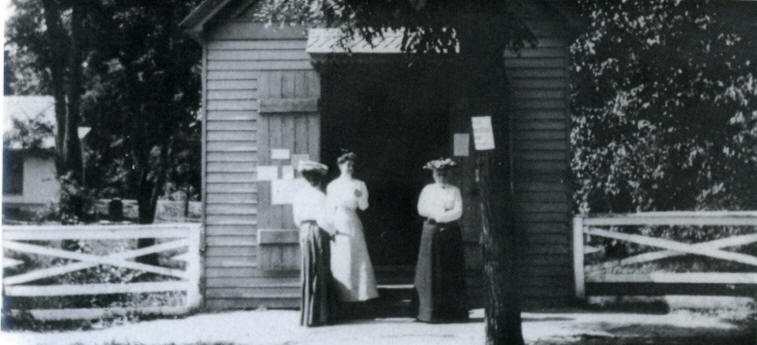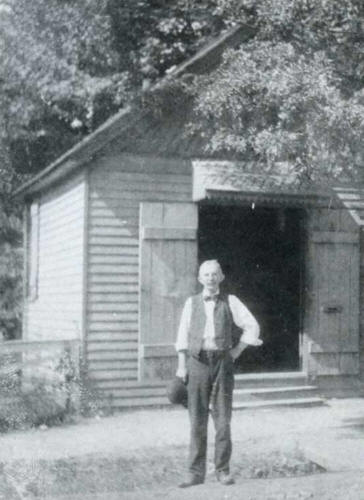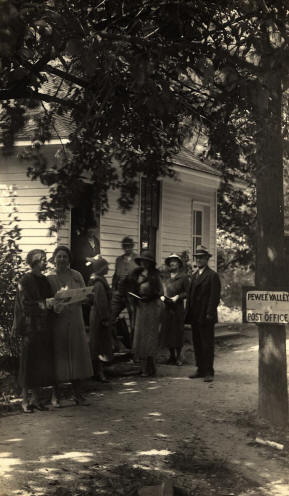The Post Office
“One had only to stroll past the little country post-office to feel the glamour of the place and meet a host of interesting characters. In those days the post-office was little more architecturally than a magnified dog kennel, but at nine o’clock of a summer morning it was the social centre for an animated half hour or more.
The smart equipages of summer residents were drawn up in front of it. Old family carryalls loaded with children in care of their black mammies jointed the procession, and pretty girls and their escorts on horseback drew rein in the shade of the locusts arching the road.
One half expected to find “Mars’ Chan” and “Meh Lady” among them, for the families represented here were sprung from the old Virginia stock and showed their birth and breeding both in feature and in charm of manner.
There was much visiting back and forth among the carriages while they waited. Picnics and parties were planned, invitations given and accepted, recipes exchanges and gossip passed from group to group.”
Annie Fellows Johnston,
In her autobiography,
Land of the Little Colonel (1929)
So many scenes in the Little Colonel stories take place at the Lloydsboro (Pewee) Valley post office.
Records show a Post Office was established at Pewee Valley, Kentucky on February 8, 1856. It was discontinued on February 18, 1861, re-established on March 1, 1861; discontinued on November 2, 1861; and re-established November 26, 1861.
Early maps show that the post office was originally located at the railroad station. But for most of the Little Colonel stories anyway, the post office was just across the square and a little way down Central Avenue. You’d pass it on the way to The Beeches and Edgewood.

Fannie Craig (Miss Allison, center) and Mrs. Henry Lawton (Mrs. Walton, right) at the post office
(during the Little Colonel days)

Charles Calvert, early postmaster
From The Little Colonel at Boarding School, Chapter 5
From the depot it was but a few steps to the post-office. One had only to cross the road, pass the country store, and stroll a short distance along the shady avenue. There it sat by the wayside, a little box of a room, that always made Lloyd think of a dove-cote; for the first time she had been taken there her grandfather had explained that all the little square places where Miss Mattie was putting the letters were pigeonholes. Presently when Miss Mattie opened the window and handed him a letter from one of those places, she cried out with a little squeal of delight which made every one smile, “Oh, white pigeon wing flied out fo’ you, grand- fathah!”
Afterward it grew to be a byword that they always used between themselves, when one carried home a letter for the other. “Pigeon wing for grandpa’s baby,” he would call fondly, even when she had grown to be a tall girl; and “White pigeon wing flied out fo’ you, grandfathah deah was the cry if she were the bearer of the missive.
From the post-office door, looking across the road to a grassy ridge beyond, one could see the big inn that the year before had been turned into a home for old Confederate soldiers. Farther on was the wide green slope of the churchyard, and the little stone church with its ivy-covered belfry. The manse stood just behind it. Next to that was the cottage with the high green gables and diamond-shaped window-panes, where the Waltons had lived one summer while their new house was being built. And next to the cottage was the new house itself, set away back in the great grove of trees which gave to the place the name of “The Beeches.”
From The Little Colonel’s Knight Comes Riding, Chapter 5
The road in front of the post-office was almost blocked with carriages. On summer mornings like this nearly every one in the Valley found some excuse to be at the station when the mail train came in; for while they waited for the delivery window to open, there was time not only to attend to the day’s marketing, but to meet all one’s friends. At such times the little box of a post-office was the very centre of neighbourhood sociability, and since everybody knew everybody else, the gathering was as informal as a family reunion.
At some point, but still during the lifetime of Annie Fellows Johnston and possibly before the end of the Little Colonel stories, the simple old post office was replaced with a somewhat larger building as seen below, probably during the 1920s:


From left to right: Lilian Fletcher Brackett, Virginia Hoge San, Charlotte Matthews Osbourne, Hollie Jacob,
Annie Fellows Johnston, Dr. Peyton Hoge, Mary G Johnston, Donald Jacob. Photos by Kate Matthews.
Even this post office did not survive the progress of the 20th Century. It was eventually demolished and the site is now the entrance drive to St. Aloysius Church.
The following is a list of Pewee Valley postmasters and their dates of appointment from 1856 to 1945 (taken from an exhibit posted at the current Pewee Valley Post Office on Highway 146). We believe that Postmistress Mary Calvert, sister of Postmaster Charles Calvert, may have been Annie Fellows Johnston’s model for “Miss Mattie,” the postmistress in the “Little Colonel” stories.
Charles F. Smith February 8, 1856
Francis M. Crow August 28, 1857
Samuel H. Crum November 23, 1858
Thomas Smith November 23, 1858
William H. Hudson April 9, 1861
William Butler November 8, 1861
Luther Howard November 26, 1861
William J. White April 3, 1866
Henry M. Woodruff February 13, 1871
Charles A. Calvert September 9, 1889
William N. Jurey May 3, 1893
Charles A. Calvert June 21, 1897
Mary Calvert June 26, 1897
Charles A. Calvert April 16, 1907
E.H. Swann April 25, 1914
Anna B. Lipscomb March 5, 1919
Anna D. Shelman November 4, 1920
Charles W. Robinson February 22, 1922
Imogene Baumuster-Kilgus July 16, 1935
Cornelia L. Snyder January 25, 1945